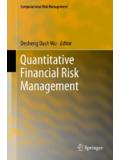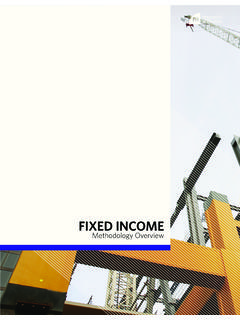Transcription of The Basel II Risk Parameters - HKFRM
1 The Basel II Risk Parameters Second edition . Bernd Engelmann l Robert Rauhmeier Editors The Basel II Risk Parameters Estimation, Validation, Stress Testing . with Applications to Loan Risk Management Editors Dr. Bernd Engelmann Dr. Robert Rauhmeier ISBN 978-3-642-16113-1 e-ISBN 978-3-642-16114-8. DOI Springer Heidelberg Dordrecht London New York Library of Congress Control Number: 2011924881. # Springer-Verlag Berlin Heidelberg 2006, 2011. This work is subject to copyright. All rights are reserved, whether the whole or part of the material is concerned, specifically the rights of translation, reprinting, reuse of illustrations, recitation, broadcasting, reproduction on microfilm or in any other way, and storage in data banks. Duplication of this publication or parts thereof is permitted only under the provisions of the German Copyright Law of September 9, 1965, in its current version, and permission for use must always be obtained from Springer.
2 Violations are liable to prosecution under the German Copyright Law. The use of general descriptive names, registered names, trademarks, etc. in this publication does not imply, even in the absence of a specific statement, that such names are exempt from the relevant protective laws and regulations and therefore free for general use. Cover design: WMXD esign GmbH, Heidelberg, Germany Printed on acid-free paper Springer is part of Springer Science Business Media ( ). Preface to the Second Edition The years after the first edition of this book appeared have been very turbulent. We have seen one of the largest financial crisis in the history of the global financial system. Banks which existed since more than one century have disappeared or had to be rescued by the state.
3 Although Basel II has been implemented by many banks so far and still a lot of effort is spent in improving credit risk management by building up rating systems and procedures for estimating the loan loss Parameters PD, LGD, and EAD, there is still a feeling that this is insufficient to prevent the financial system from further crisis. There are ongoing discussions how the financial system can be stabilized by either improving the regulatory framework or the internal risk management of banks. During the time when we worked on this second edition, the regulatory framework Basel III has been discussed. The basic idea behind Basel III is extending the capital basis of banks. It is not the aim of Basel III to improve the methods and processes of banks' internal credit risk management but simply to improve system stability by increasing capital buffers.
4 Since we did not view this book as a book on regulation (although it was motivated by a regulatory framework) but as a book on risk management, we do not discuss the current regulatory ideas in this edition. Instead, we focus on one of the causes for the financial crisis, the lending behaviour of banks in the retail sector. By retail, we mean lending to debtors where no market information on their credit quality, like asset swap or credit default swap spreads, is available. This is the case for almost all loans except for loans to large corporations, states or banks. In the recent financial crisis one of the origins was that American banks granted mortagage loans to too many debtors with low income. By assuming that house prices could not fall sharply it was thought that the value of the loan's collateral will be sufficient in the case of a default to ensure that no loss occurs.
5 A large number of bankruptcies among the banks which had invested in the American housing sector and expensive rescue programs for banks that were considered as too important to fail are the result of this wrong assumption. The consequences of the financial crisis are not yet clear. The question how an optimal financial system has to look like is difficult to answer. On the one hand the lending behaviour of banks should not be too restrictive because this will obstruct the real economy. On the other hand it must be restrictive enough to prevent the v vi Preface to the Second Edition creation of bubbles. The same considerations are true for the spectrum of financial products. There should be enough vehicles for banks and corporations to manage their risks but the complexity and the volume of derivative instruments should not lead to a less stable financial system.
6 We do not attempt to give an answer to this complex question. Contrary to some opinions in the aftermath of the crisis that blamed mathematical models as its main driver, we still believe that mathematics and statistics are valuable tools to quantify risks . However, one has to be aware that this cannot be done with arbitrary precision. The role of a model in our view is more to increase the transparency of a bank's business and to identify key risks . We want to illustrate this view by presenting a pricing framework for retail loans that shows how the Basel II risk Parameters can be used in building a simple and transparent framework for the pricing and the risk management of loan portfolios. In our view an increase in transparency in the loan market is a necessary prerequisite of any risk management or regulatory action.
7 Compared to the first edition, we have extended the book by three new chapters. In estimation techniques for transition matrices are presented and their properties are discussed. A transition matrix is a natural extension of a 1-year default probability since it measures all transitions of a rating system not only the transitions to default. It is an important building block of the loan pricing frame- work that is presented in and 18. In it is shown how the Basel II. risk Parameters can be used to build a risk-adjusted pricing framework for loans that can be applied to compute a loan's term based on RAROC (risk-adjusted return on capital) as performance measure and to calculate general loss provisions for a loan portfolio in an economically sensible way.
8 Furthermore, this framework allows for an easy stress testing and answering of questions like: What happens if the value of collateral turns out to be 10% lower than assumed? In , the pricing framework is extended in a consistent way to loans with embedded options using option pricing theory. Often a loan contains prepayment rights, a debtor has the right to pay back parts or all of the notional at certain dates or throughout the loan's lifetime without penalty. We demonstrate that the value of such an option is too large to be neglected and show further how to include embedded options into the RAROC framework of Finally, we would like to thank Martina Bihn from Springer-Verlag again for her support of this second edition and last but not least our families for their support when we again spent a lot of time working on it.
9 Questions and comments on this book are welcome. The editors can be reached under their e-mail addresses and Frankfurt am Main, Germany Bernd Engelmann Munich, Germany Robert Rauhmeier December 2010. Preface to the First Edition In the last decade the banking industry has experienced a significant development in the understanding of credit risk. Refined methods were proposed concerning the estimation of key risk Parameters like default probabilities. Further, a large volume of literature on the pricing and measurement of credit risk in a portfolio context has evolved. This development was partly reflected by supervisors when they agreed on the new revised capital adequacy framework, Basel II. Under Basel II, the level of regulatory capital depends on the risk characteristics of each credit while a portfolio context is still neglected.
10 The focus of this book is on the estimation and validation of the three key Basel II risk Parameters , probability of default (PD), loss given default (LGD), and exposure at default (EAD). Since the new regulatory framework will become operative in January 2007 (at least in Europe), many banks are in the final stages of implementation. Many questions have arisen during the implementation phase and are discussed by practitioners, supervisors, and academics. A best practice . approach has to be formed and will be refined in the future even beyond 2007. With this book we aim to contribute to this process. Although the book is inspired by the new capital framework, we hope that it is valuable in a broader context. The three risk Parameters are central inputs to credit portfolio models or credit pricing algorithms and their correct estimation is therefore essential for internal bank controlling and management.





